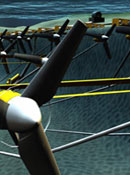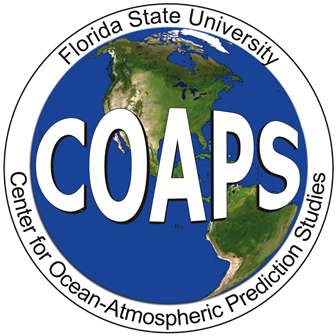As energy demands and costs continue to increase, scientists at COAPS are contributing to alternative energy research focusing on both land-based and marine renewable technologies. Preliminary studies indicate that both offshore winds and ocean currents may be viable sources of renewable energy from the oceans surrounding Florida. Use of solar power is expanding across Florida and land-based wind power is also being researched. For more information, see the summaries below.
Offshore Wind Energy

In collaboration with the Business Network for Offshore Wind, the Southeast Wind Coalition, Power-US, and representatives the wind power industry, we have been exploring available offshore wind resources in Florida’s coastal waters. Our focus is using climate data to compute the available wind resource in Florida’s coastal waters on annual, seasonal, and diurnal time scales. Surface wind data are obtained from coastal and offshore locations, including buoys and fixed tall towers. In addition, COAPS scientists have the expertise in assessing the risks associated with tropical storms and hurricanes which can adversely impact offshore wind infrastructure.
Preliminary results from a 2010 study (funded by Florida State University Institute for Energy Systems, Economics, and Sustainability) indicate that the northeastern Gulf of Mexico has the potential to generate several thousand megawatts of power for Floridians. A more recent analyses indicate even more potential when taking the seasonal and diurnal cycles of coastal wind into account. These studies will provide the offshore wind industry with information that could lead to the development of an offshore wind industry for Florida which can create and support new jobs. For more information, contact
COAPS Offshore Wind Energy Fact Sheet (PDF)
Marine Biofuels
Interest is growing in using the marine environment to farm algae as a source of biofuel. COAPS has access to observing sites, with atmospheric and ocean instrumentation, and expertise in coupled ocean-atmosphere-ecosystem modeling that can be leveraged to research topics of interest to this new area of alternative energy research.
The Florida Current

Scientists at COAPS and Florida Atlantic University's Center for Ocean Energy Technology have investigated the possibility of harnessing energy from strong ocean currents off Florida's east coast to help power Florida. The scientists used global ocean prediction models to assess and predict power availability in the Florida Current, a section of the Gulf Stream System which extends from the Florida Straits to Cape Hatteras, and also assess the impact underwater ocean turbines might have on the Florida Current and Gulf Stream. For more information, contact

